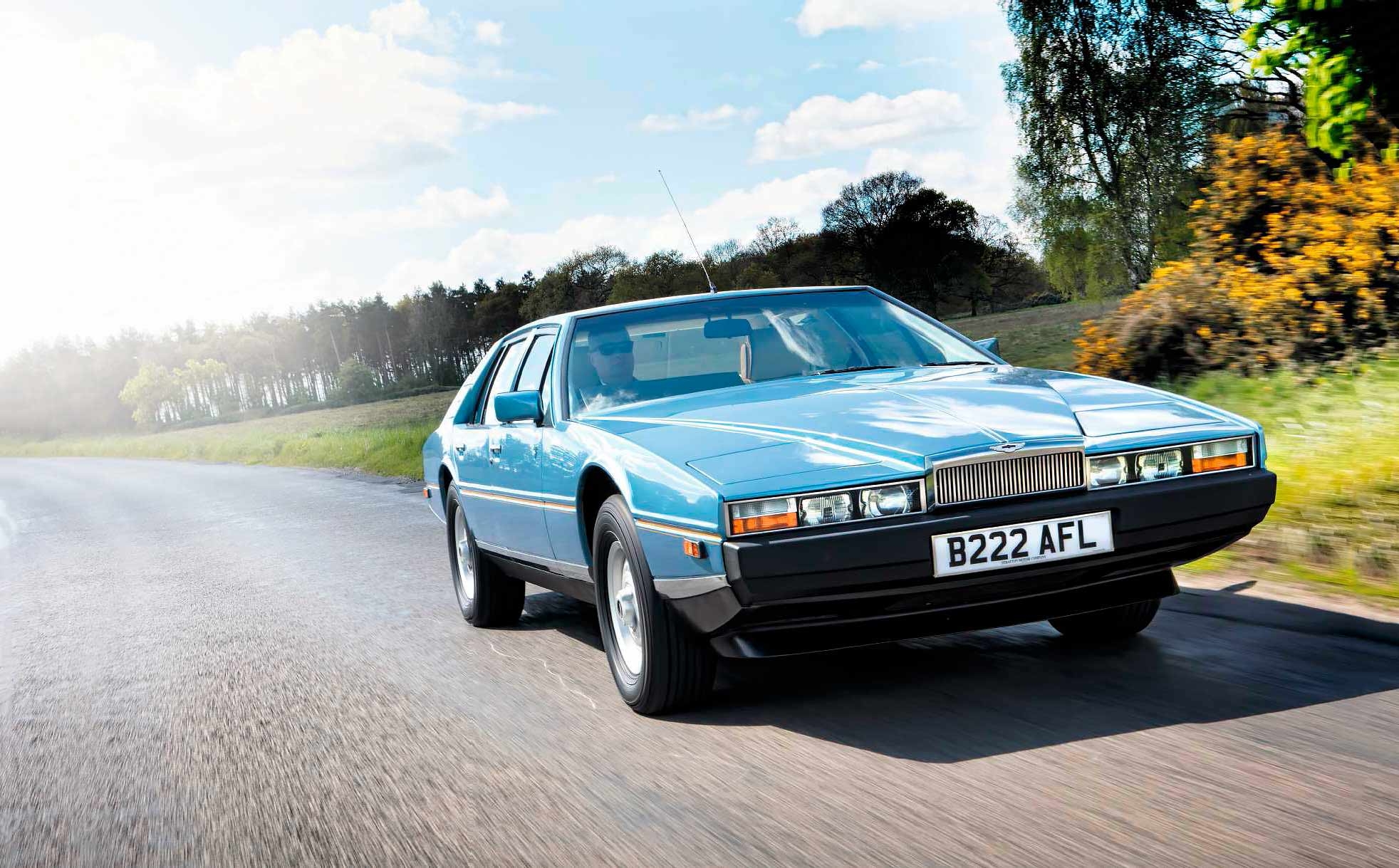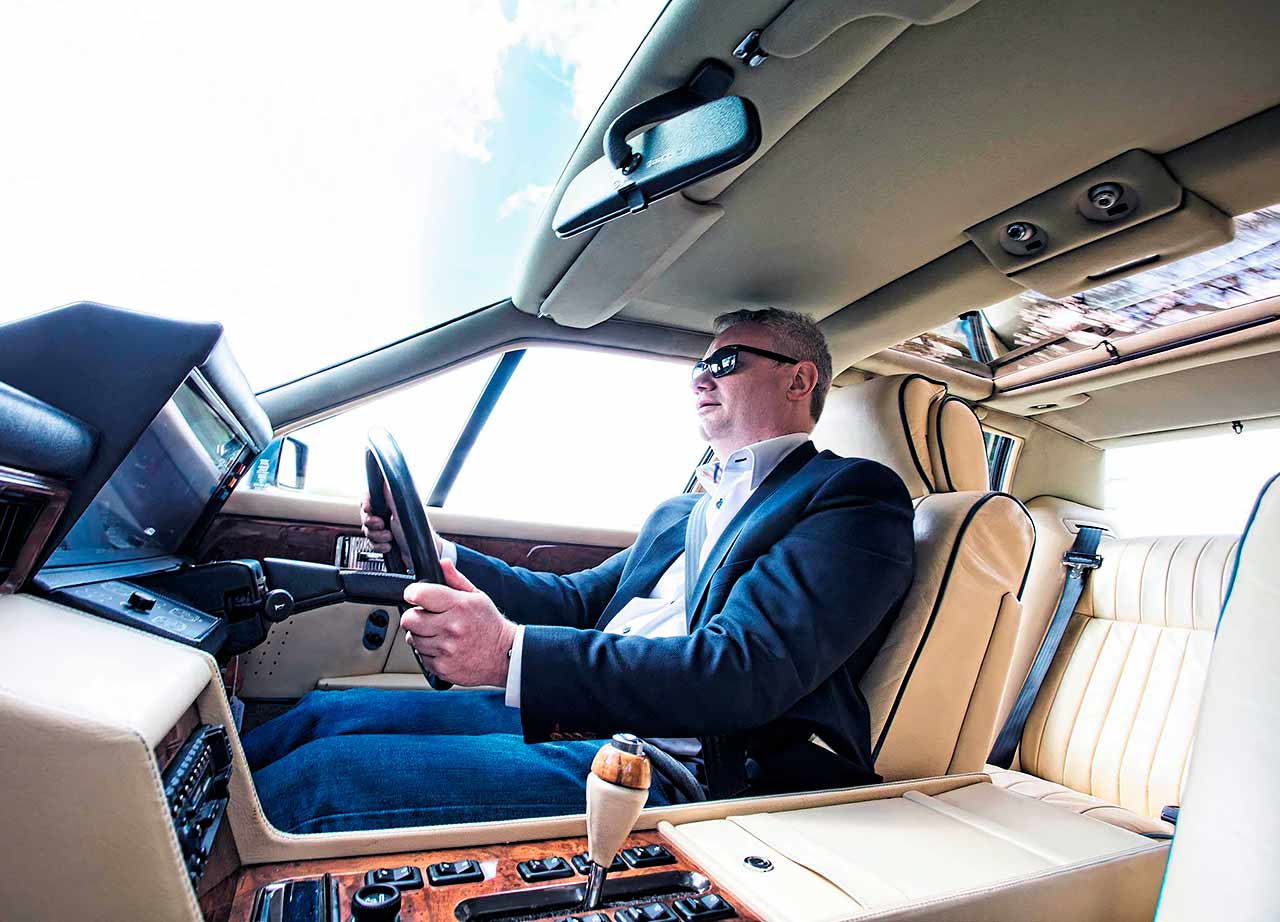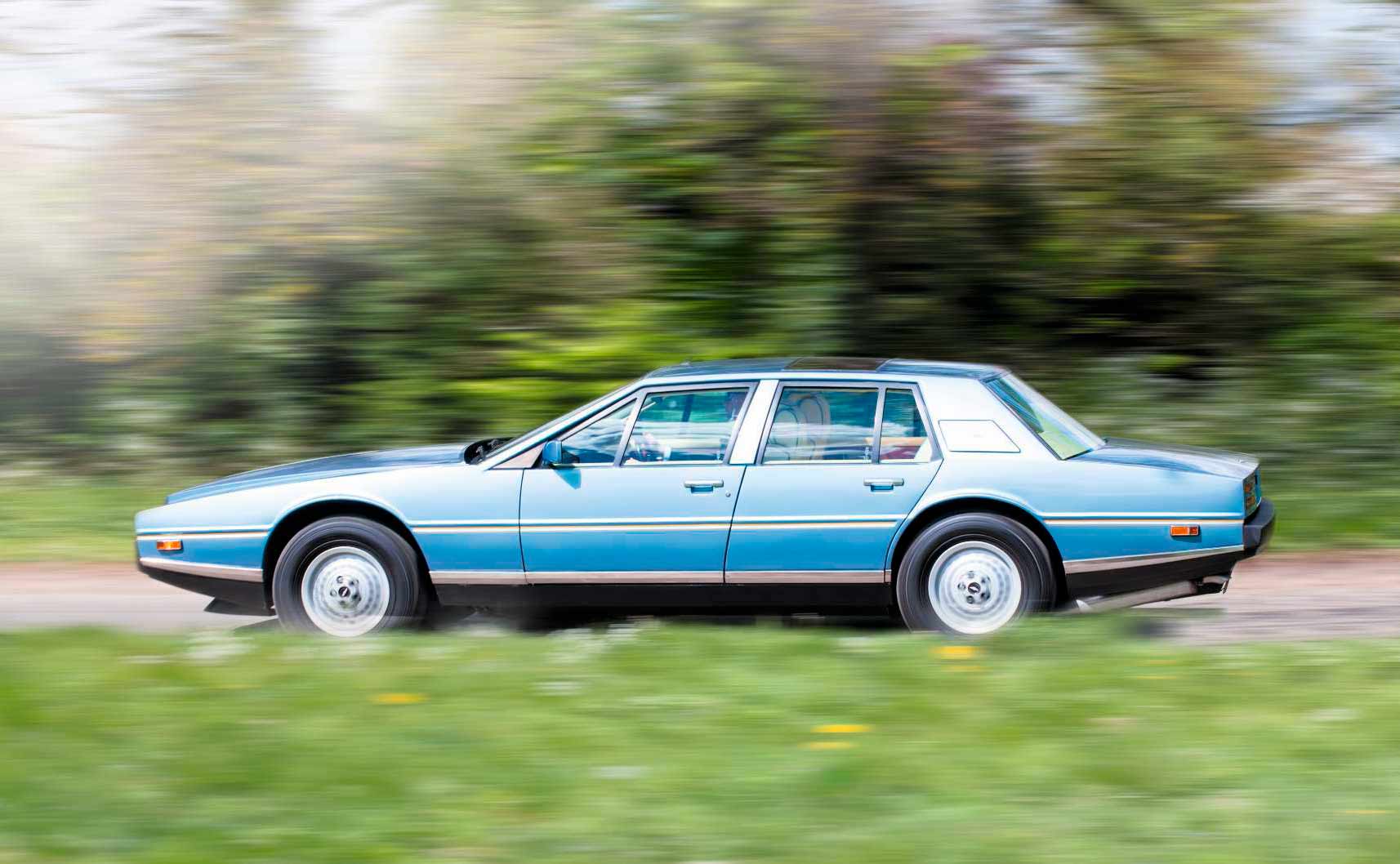
Andy Morton had two dream cars when he was young. He’s owned one – A Porsche 928 – and was disappointed. Will the other, Aston Martin’s high-tech Lagonda, live up to 40 years of expectation? Words Sam Dawson. Photography Neil Fraser.
‘It’s like nothing else on Earth!’ The List Your dream drive made real
READER WINS A LAGONDA DRIVE ” YOU NEXT MONTH?
When I first encounter Classic Cars reader Andy Morton, he’s strolling across the gravel driveway behind Aston Martin specialist Stratton Motor Company’s Norfolk premises clutching a small white hardback book. It’s his cherished 1976/1977 copy of The Observer’s Book of Cars.
‘It all started here!’ he exclaims, gesturing with it. ‘This was the first car book I ever owned, and I used to use it to decide which cars I wanted to own in the future. My favourites were the Porsche 928, which I’ve owned; the Panther Six, which never made it into production; and the Aston Martin Lagonda, which I’ve never been able to afford. Now you’ve arranged for me to drive one, which is a chance I know I’m never going to get again. I’ll definitely be making the most of it.’

‘The digital dashboard is ridiculous – but it’s also intrinsic to the Lagonda’s character’
We round a corner bisected by a high brick wall, and Morton looks up from his childhood memories. There, its metallic blue paintwork shimmering in the sunlight, is the Lagonda he’s finally going to get to drive. His jaw drops.
‘In the book it was described as “the space-age super-saloon”,’ Morton recalls as he walks around it, slowly and reverentially, unable to take his eyes off its severe lines. ‘It’s like nothing else on Earth. It’s also really long – funnily enough the last time I saw one – a long time ago now – its driver was trying to turn it around in a cul-de-sac. It took him ages.’
Morton decides to try the Lagonda out for size, and opens the drivers’ door, noticing a humble detail in a sea of bespoke exoticism. ‘It’s got the same door handles as my Dad’s old Cortina MkIV,’ he notes. ‘Had I known that at the time I would’ve thought that old Ford was much cooler than I did, to know that the means of entry was the same as an Aston.’ Funnily enough, the door handles cost Aston more expense than expected because, for diplomatic reasons, the Middle Eastern market that formed the bulk of its early sales didn’t want to feel it was buying an American product. Anticipating this, someone at the Newport Pagnell factory was given the laborious task of filing the Ford badges off the underside of all the handles.

1984 Aston-Martin Lagonda road test
Morton settles into the deep-pile padding of the drivers’ seat, closes his eyes and inhales the leather odour. When he opens them again he finds himself staring at a bewildering dashboard, all black digital panels and touch-sensitive plastic membrane switches, and it takes us a full five minutes and a fruitless recourse to the owners’ manual to work out how to activate the famous pop-up headlights. ‘If the dashboard goes wrong, does a Rediffusion man in a Bedford Beagle van come out to fix it? The wheel’s so tiny and still futuristic with its single spoke. It all reminds me of early computers, especially with this wood veneer, it’s got one foot still just-about in the past.’ There’s something familiar about it though, thanks to a particular model that’s had a recurrent presence in Morton’s ownership.
‘It reminds me of my Jaguar XJ6s,’ he explains. ‘The driving position’s almost identical, right down to the unexpectedly low headroom and narrow footwell.’ He turns the ignition key and the 5.3-litre Aston Martin V8 awakes from its slumber with a distant rumble. ‘You don’t get that with a Jag though!’ quips Morton, who then pulls the vast Lagonda into the traffic of the A140.
‘It’s much more eager off the line than I was expecting,’ he notes as the Lagonda gathers speed. ‘I thought it would be a bit ponderous, like a Rolls-Royce. You sit higher than I thought, too, compared to the window line. It’s superb for cruising – all the light coming in through the windows and that huge sunroof over the back seats, plus the light-coloured leather, gives it a real sense of airiness inside.’ After a few miles, we pass a national speed limit sign and an awkward situation arises.
‘I love the dashboard but it’s not very well laid out,’ says Morton. ‘The speedometer readout is in the top right-hand corner and my hand obscures it, but what’s worse is that I know one of the Lagonda’s party tricks was the ability to switch between miles and kilometres per hour at the touch of a button, which really appealed at the time as it hinted at its ability to speed across continents. I know which button it is, but there’s no indicator to say what mode it’s in and at low speeds it’s really hard to tell.’
It’s not the only oddity. Because of the uniform size of all the digital readouts, all the numbers on the dashboard are the same – giving the tucked-away speedometer no more prominence than the clock. Also, temperatures and pressures are difficult to gauge against normality when they’re not presented on a conventional dial with obvious parameters. And there are no indicators next to the gear lever to tell you which setting it’s in – they appear in a non-linear manner on the dashboard.
‘It’s annoying but it’s also intrinsic to the character of the car,’ says Morton. ‘I wouldn’t change it for anything else, to do so would be missing the point somehow.’
We turn off onto a complex of B-roads towards the Norfolk Broads, and Morton delves into the car’s dynamics as the roads start to undulate. ‘It rides more firmly than I expected – more like a Jaguar XJR than a Bentley or Rolls-Royce – and it makes a glorious noise too. The V8’s sound intrudes into the cabin more than I thought it would, but it’s a sound you want to hear, plus it’s not loud enough to stop you having a conversation.
‘The wheel’s heavier than a Jaguar’s but not too heavy, just as well as it feels like it’s the size of a little button. I suppose with the single spoke they were freeing up space in front of the dashboard, which it does, but thanks to the layout I’m getting a great view of the clock!’ He’s not put off though – a grin is breaking across his face as he massages the Lagonda through the rural sweepers.
‘It feels very planted too. In combination with the ride it really imparts a sense of confidence in the driver. It’s taut rather than overly firm, and what really surprises me is how compact it feels. From the outside those massive overhangs and the way that the glass area extends all the way from one extremity of the car to the other without any tumble-home in the bodywork sides makes it seem massive, but it’s certainly no longer than a Jaguar XJ and it actually feels quite narrow, more so than my day-to-day Volvo. I feel quite confident in calling it a sports saloon rather than a luxobarge.
It compares very well to an XJR and I imagine it’d bear closer comparison to a Maserati Quattroporte than the Rolls- Royce Silver Spirit that CAR tested it alongside in 1980 – I read that feature last night in preparation – but the car’s really surprised me with its sportiness, which that magazine didn’t pick up on. It makes me wonder whether it gave Bentley the idea to create the Mulsanne Turbo – that supposedly strikes a similar balance although I can’t imagine it being quite so good as a drivers’ car – it doesn’t sound this good for starters.’ We reach a rare straight near Stoke Holy Cross and Morton opts to demonstrate his point.
‘Watch this,’ he says as he straightens the tiny wheel and jams his right foot down hard on the accelerator pedal. There’s a discernible, immediate jolt, well-damped through acres of suspension and upholstery, as the car squats on its haunches and rockets forward on an endless-feeling jet of torque. ‘I just didn’t expect it to be quite so responsive,’ says Morton. ‘I feel like an airline pilot nudging the throttles forward, especially when coupled with a dashboard giving me too much information.’
We do soon encounter a weakness though when turning into a small residential street, recalling the last time Morton saw a Lagonda. ‘The steering lock’s not great is it?’ He notes. ‘I can feel it rocking on its suspension at parking speeds – it makes you realise how softly-sprung it is, and yet it doesn’t wallow when you’re up to speed. Aston did a really sophisticated job getting it just right.’ Morton is perceptive – the preceding V8-based Series 1 version of the Lagonda was thought too floppy and flexible, so engineer Mike Loasby introduced extra strengthening measures with the Series 2 including a strong roll hoop running around the car at the B-pillars and extra box-sections in the chassis. The result actually keeps its bulk in check better than its concurrent Series 2 AM V8 sister model, even if the Lagonda’s extra weight ultimately blunts its performance.
Not that Morton or I notice any real difference on the road. ‘It’s impossible to drive it economically,’ he enthuses. ‘I’d never tire of that noise – it’s like a distant rumble of thunder that never lets you forget it’s an Aston Martin at heart. In some ways that’s the most surprising thing about it. I was expecting a limousine and ended up with a true sports saloon. Its acceleration is a sudden gathering of speed rather than a neck-snapping thud, and the brakes only just inspire enough confidence – they’re a bit spongy and you really feel the car’s mass when braking hard – but I’m amazed at what happens when you take a reasonably tight corner at speed. It remains composed and seems to shrink around you the faster you go – if it wasn’t someone else’s car I’d be going a lot quicker than this! And the ride is incredible – it lets you know what’s going on and there’s plenty of communication through the wheel, but it doesn’t punish you over long distances. My modern luxury-specification Volvo is far worse and it’s not even trying to be sporty. A lot of fine-tuning went into this car.’
He’s right about its fuel economy though. After a long meandering drive we pull into a filling station for petrol before heading back towards Long Stratton. The filler flaps are awkwardly sited – the ignition needs to be on to electrically release them, they hinge upwards and the caps underneath are horizontal, leading to a tricky threading action with the petrol pump to avoid scratching the surrounding bodywork. As motorists emerging from the kiosk stop to admire the Lagonda, Morton ponders ownership.
‘Would I have one? Money no object? I absolutely would! It would have to be the earliest version with its steel disc wheels – although these Jaguar-sourced pepperpot alloys are attractive, the steels are more unusual. One of the reasons I’d want one is actually because few people know what it is. I’d rather have something enigmatic than obvious, and as a result I’d have this over anything more overtly badged Aston Martin. And what impact, what drama when you open it up and it comes alive!’
Thanks to: Roger Bennington, Stratton Motor Company (strattonmotorcompany.com)
TECHNICAL DATA FILE SPECIFICATIONS 1984 Aston Martin Lagonda
Engine 5340cc V8, dohc per bank, four Weber 42 DCNF carburettors
Power and torque 280bhp @ 5000rpm; 302lb ft @ 3000rpm DIN
Transmission Three-speed automatic, rear-wheel drive
Steering Power-assisted rack-and-pinion
Suspension Front: independent, double wishbones, coil springs, telescopic dampers, anti-roll bar. / Rear: de Dion axle, parallel trailing arms, Watt linkage, coil springs, telescopic dampers.
Brakes Discs front and rear
Weight 1980kg (4365lb)
Performance Top speed: 145mph; 0-60mph: 7.9sec
Fuel consumption 16mpg
Cost new £49,933
Values now £25,000-£60,000
‘I feel like an airline pilot nudging the throttles forward, especially when coupled with a dashboard giving me too much information’
‘The last time I saw one its driver was trying to turn it around in a cul-de-sac. It took him ages’
ANDY’S DREAM DRIVE LIST
Isotta Fraschini Monterosa Do any even exist? I’d love to find out.
Citroën SM My uncle had one but I never got to drive it – damn!
Porsche 911 Turbo 3.3 930 Is it as fearsome as everyone says? I’d love to find out – but hopefully not the hard way!
Ferrari 375MM I’ve never actually seen one, but all those pictures left an impression.
Lamborghini Islero A usable Miura? And it looks so understated – lovely!
Iso Grifo Was it an Italian supercar that could be used as your one and only car?
Pegaso Z102 Nothing on earth looks like one. The weirder the better.
Maserati Quattroporte I I love big saloons.
Ferrari 365 GTB/4 Daytona Butch but beautiful. For me the best non-375MM Ferrari.
Raw data harder to assimilate without the context of a guage. Selector for TorqueFlite auto ’box leaves you guessing where the positions lie. Sam and Andy try to decode the Seventies-futurist digital dashboard. This late Series 2 Lagonda runs on four Webers; electronic injection was introduced a year later. A HMS-spec horn is vital when navigating such a magisterial vessel. Conventional odometer in the engine bay because dash electronics not relible enough. The Lagonda leaves a distinct impression on reader Andy – and anyone else left in its wake.
ANDY MORTON’S CAR CV
Morton’s tastes are divided between the large and luxurious and the small and Italian.
LANCIA Y10 TURBO
‘My first car, not common back then and rarer than a Ferrari Daytona today. An essay in turbolagged all-or-nothing performance, plus no garage I took it to had ever seen one before so getting it repaired was tricky. When we got it on the ramps I realised the exhaust pipe was made at least in part of old Fanta cans.’
JAGUAR XJ6 SERIES 3
‘My first Jaguar, bought when I was 26. I wasn’t earning much at the time so it wasn’t the best, but when I first parked it on my Dad’s drive his response began with an F! He had a Cortina at the time.’
PORSCHE 928
‘It was another one of those childhood dream cars inspired by that Observer’s book. An uncle had one, and he’d just done a deal on a newer 944 so the 928 was surplus to requirements. He asked me if I wanted it and it was an itch I had to scratch. Sadly it was a case of “never meet your heroes” – it just didn’t excite me. It wasn’t very engaging and didn’t impart a sense of the massive speeds it was capable of at all.’
JAGUAR XJ6 (XJ40)
‘I wasn’t going to buy another Jag, but this one was a manual and very rare so I couldn’t say no. Turned into a restoration project when it started going rusty and I’ve only recently sold it.’
FIAT PANDA 100HP
‘Amazing character for a more modern car – within ten yards I knew I’d have to buy it. I miss more ‘classic’ character like unassisted steering and uneven carburetted idle, but I’ve never known a faster-cornering car. It could maintain such good average speeds on B-roads that my brother struggled to keep up in his Skoda Octavia vRS.’





